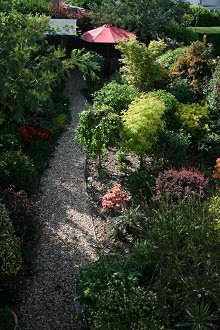It was while lying on the beach at Shell Bay yesterday, relaxing after a long day of Acacia pruning in our own garden, that I was reminded to write this post whilst reading the latest New Scientist magazine.
Very often we talk of plants that are carnivorous, such as the Venus Flytrap, or others that move, such as Mimosa pudica, but what often comes to my mind is the question 'Are plants as sensorily aware as we are?'
TOUCH
It's quite obvious that plant's respond to touch in various ways. In almost exactly the same way that you or I can feel a fly walking on our arm due to the touch receptors in our skin sensing it, and sending electrical currents to our brain informing us of the fact, so that we can choose whether or not to do anything about it, so the Venus Flytrap has an almost identical sense of touch. When an insect touches two or more hairs within it's modified leaves, a current is produced that passes through the leaves. This in turn activates the cell membranes, causing the trap to spring shut on the bug. Similarly, Mimosa pudica (Sensitive Plant), being of a very delicate structure, can detect when rain falls on it's leaves, and they close up to prevent damage from the heavy rain droplets that fall in the areas that it grows. Most of us just have fun touching them and making them close ourselves. I could go into detail about mechanoreceptors and charged ions etc, but you can read up yourself if interested. There is no doubt though, that although plants don't have a brain in which to translate these signals into emotional responses and the like, their sensitivity to touch does let them respond to a changing environment in very specific ways.
SMELL
Our own sense of smell is available to us because each of us have receptors in our nose that detect various chemicals in the atmosphere around us. These chemicals trigger differents types of electrical currents that our brain then differentiates between, allowing us to tell the difference between a banana and a bowl of acid.
All plants also have receptors that respond to chemicals, making them respond in various ways. Cuscuta europaea (Dodder), in the picture above, is a parasitic plant with virtually no chlorophyll (the substance that makes plants green), hence it's pale appearence. As plants need chlorophyll to convert light, Co2 and water into sugar, it must get it's sweet stuff in another way. It's extremely sensitive to the odours given off by other plants, and can differentiate between host plants that are favourites, and other's that are not so good, or harmful to it. Once attached to it's host, it feeds away. Exactly like we do, when we smell foods we like or dislike. For me it's the difference between a jam doughnut and cooked cheese.
In another way, all ripening fruit emits large amounts of ethylene, that pungent metallic smell you get when bananas are over ripe. Receptors in surrounding plants 'smell' the ethylene through their receptors, and this speeds up their own ripening. This is a fascinating area, and I recommend reading up some more on it.
Our noses and mouths are physically linked, because our noses detect volatile (evaporated) chemicals, and tongues detect soluble chemicals. As food is chewed, this combination allows us to smell the food as we chew it. These two senses are also linked in plants, and can be best seen in the way they deal with an attack from a pest or disease. When under attack, plants emit all sorts of chemicals into the atmosphere around them, but probably the most important is one called methyl jasmonate.
Stomata
Once this chemical is taken in through the stomata on the leaves of another plant, it gets converted into jasmonic acid, enabling the plant to react to the attack in whatever way it can, perhaps in the form of becoming inpalatable to the attacking insect. Most of a plants sense of taste are in it's roots, not surprising as these are surrounded by water and soil, and it's been proven that they can communicate 'root to root' with other plants, in the form of soluble chemicals being emitted underground, and 'tasted' by other plants in the area. An experiment showed that when a row of plants was subjected to drought conditions, the plants in that row responded by closing their stomata to reduce water loss. More importantly however, within one hour, all of the other plants in the other rows, that weren't put under drought conditions, had responded in the same way. The dry ones has communicated root to root, by way of soluble chemicals. We can simply taste or sense that something is bad, and tell others through speech.
SIGHT
Codariocalyx motorius (Telegraph Plant)
We have photoreceptors in our eyes that convert various forms of light and image into electrical currents, that our brains then form into some sort of usable image for us to react to. Plants also have photoreceptors in their leaves and stems. They can tell the difference between blue and red light, and even 'see' types that we can't, such as infrared and ultraviolet. They can tell which direction light is coming from (most interestingly seen in a sunflower field), how dim or bright it is, and even when it goes out, a good example being the old favourite Mimosa pudica, whose leaves close when light becomes too dim for it to use effectively. Just as the images that we see trigger a response from us, plants will react to their own 'vision'. The Telegraph Plant (above), moves it's leaves in the direction of the best sunlight, but to save energy it has much smaller leaves that do the detecting and spinning around every few seconds, enabling the much larger main leaves to only move occasionally, once optimum direction has been established and indicated to them by the smaller leaves.
Most flowers, we all know, point to wherever the sun is at any given point in the day, having been told to do so by the receptors in the leaves.
HEARING
Let's face it, plants cannot hear in the same way that we do, as that needs an eardrum and three special bones to make the electrical signals that need unravelling into something coherent. Maybe they don't even hear in some way at all. It would appear that some believe plants respond to talking or classical music, and with sound being simply a set of vibrations in the air, I expect that plants would be able to detect and react to these in some way through the myriad receptors that they have. As food for thought though, an interesting study carried out at the University of Western Australia involved the seeds of Capsicum annuum (Chilli Pepper) being placed in eight petri dishes, and arranged around a Foeniculum vulgare (Fennel) plant. Fennel releases chemicals that slow the growth of the Chilli down, as the experiment showed. However, using various combinations of the Fennel being present, and not present, and sealed in an airtight box (thus preventing any chemicals being transferred), the Chillis grew fastest when the Fennel was sealed up, prompting a conclusion that some form of communication between the two types of plant had taken place, and the Chillis had reacted to the threat of slow growth to come, by putting on a growth spurt! It was suggested that sound was the way it happened......Food for thought!
So there we have the five senses that we share with plants. If only they had a brain, they may have destroyed the earth even faster than we have. The first picture symbolises a Mandrake plant, Mandragora officinarum.
Thanks for taking a look.



























































Interesting. .I had no idea!!
ReplyDeleteWhen you hug a tree, it hugs you back :)
DeleteI really like the idea of the plants communicating through their roots. How interesting. Some seem obvious but I never considered sound being something a plant could "hear."
ReplyDeleteThey are quite amazing things. Sound is only vibrating air waves, and if that can be detected in some way, you have the capability to hear.
DeleteI truly believe that there is a big connection to all of these things you've mentioned with our own senses. While putting a garden together, I think about the connection that will establish between plants. The most interesting bit is how it all connects and joins together as one. It may be a bit different from our own perception but it does exist. Walking trees that search for water. Trees that drop their limbs to rid itself of aggressive vines. I learned a lot in the Amazon a couple summers back plus last summers adventure to Panama gave me some more hindsight into all of it.....we do need to take a closer look at these things and not laugh them off as most people do. It's a pretty incredible world.
ReplyDeleteI think that all living things are far more intrinsically linked than we realise. As humans, we've lost most of that feeling of connection and awareness unfortunately. When I was younger, I regularly slept in the open forest overnight, and felt the life around me.
Delete